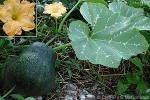Cook Islands Biodiversity Database
Species Page
Cucurbita pepo Pumpkin
MōtiniPumpkin
Multimedia & Additional Resources
| Type | Description | Download |
| Leaves, flowers and fruit | 91KB |
General Information
Cook Islands Distribution
| Southern Group: Present Makatea: Present | ||||||||
RR |
MG |
AT |
MK |
MT |
AK |
PL |
TK |
MN |
++++ |
+++ |
++ |
+++ |
++? |
++? |
- |
||
| Northern Group: Present | |||||
TN |
MH |
RK |
PK |
NS |
SW |
++ |
++? |
++? |
+ |
P |
- |
Scientific Taxonomy
Cucurbita pepo Pumpkin Linnaeus
TAXONOMY: PLANTAE; ANTHOPHYTA (=Angiospermae); MAGNOLIOPSIDA (=Dicotyledones); DILLENIIDAE; Violales; CUCURBITACEAE
More Information
SIGNIFICANCE NOTES -
POSITIVE SIGNIFICANCE: Medicine, Food (Fruit 4+), Medicine. Comments: An important food plant.
GENERAL NOTE: This species was first recorded in Europe in the herbal of L.Fuchs (1542). "an early introduction into the Pacific apparently brought to Tahiti in 1767 by Wallis" [ACSmith, Flora Vitiensis Nova].
A native of Mexico, cultivated since at least 5000 BC, and in pre-Columbian times spread across the USA. Introduced into Tahiti by Wallis in 1767, the first European to visit the island [check- was it this species, give reference]. The pumpkin and the orange were the first plants obtained by Rarotongans directly from Europeans. They visited Rarotonga after they left Tahiti for the final time in search of an island to settle - they sailed west as far as the Lau islands of Fiji, before turning eastward and eventually settling on Pitcairn.
Vouchers & References
Vouchers:
None Recorded.
References:
p.813 Neal - In Gardens of Hawaii
p.383 Tropica
p.2/681 A.C.Smith - Flora Vitiensis Nova
p.103 Wilder - Flora of Rarotonga
p.381d Whistler - Ethnobotany of the Cook Islands
Data Update History (information):
zTX, zB02, zM02, upM05a, zD02
Web Resources
Citation Information
McCormack, Gerald (2007) Cook Islands Biodiversity Database, Version 2007.2. Cook Islands Natural Heritage Trust, Rarotonga. Online at http://cookislands.bishopmuseum.org. ![]()
Please refer to our use policy.

